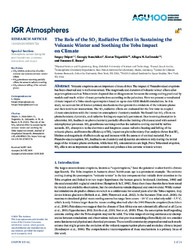The Role of the SO 2 Radiative Effect in Sustaining the Volcanic Winter and Soothing the Toba Impact on Climate
DOI: https://doi.org/10.1029/2019JD031726
Persistent URL: http://resolver.sub.uni-goettingen.de/purl?gldocs-11858/9201
Persistent URL: http://resolver.sub.uni-goettingen.de/purl?gldocs-11858/9201
Osipov, Sergey; Stenchikov, Georgiy; Tsigaridis, Kostas; LeGrande, Allegra N.; Bauer, Susanne E., 2020: The Role of the SO
2 Radiative Effect in Sustaining the Volcanic Winter and Soothing the Toba Impact on Climate. In: Journal of Geophysical Research: Atmospheres, Band 125, 2, DOI: 10.1029/2019JD031726.
 |
Dokument öffnen: |
Volcanic eruptions are an important climate driver. The impact of Pinatubo-sized eruptions has been observed and is well constrained. The magnitude and duration of volcanic winter effects after supereruptions such as Toba remain disputed due to disagreement between the strong cooling predicted by models and much milder climate perturbations according to the paleodata. Here we present a reevaluated climate impact of a Toba-sized supereruption based on up-to-date GISS ModelE simulations. In this study, we account for all known primary mechanisms that govern the evolution of the volcanic plume and their nonlinear interactions. The SO
2 radiative effects are evaluated for the first time in coupled climate simulations with the interactive atmospheric chemistry module. We found that SO
2 effects on photochemistry, dynamics, and radiative forcing are especially prominent. Due to strong absorption in ultraviolet, SO
2 feedback on photochemistry partially offsets the limiting effect associated with aerosol microphysical processes. SO
2 greenhouse warming soothes the radiative cooling exerted by sulfate aerosols. SO
2 absorption in the shortwave and longwave causes radiative heating and lofting of the volcanic plume, and boosts the efficiency of SO
2 impact on photochemistry. Our analysis shows that SO
2 lifetime and magnitude of effects scale up and increase with the amount of emitted material. For a Pinatubo-sized eruption, SO
2 feedbacks on chemistry and dynamics are relevant only during the initial stage of the volcanic plume evolution, while local SO
2 concentrations are high. For a Toba-sized eruption, SO
2 effects are as important as sulfate aerosols and produce a less extreme volcanic winter.
Statistik:
ZugriffsstatistikSammlung:
This is an open access article under the terms of the Creative Commons Attribution License, which permits use, distribution and reproduction in any medium, provided the original work is properly cited.

